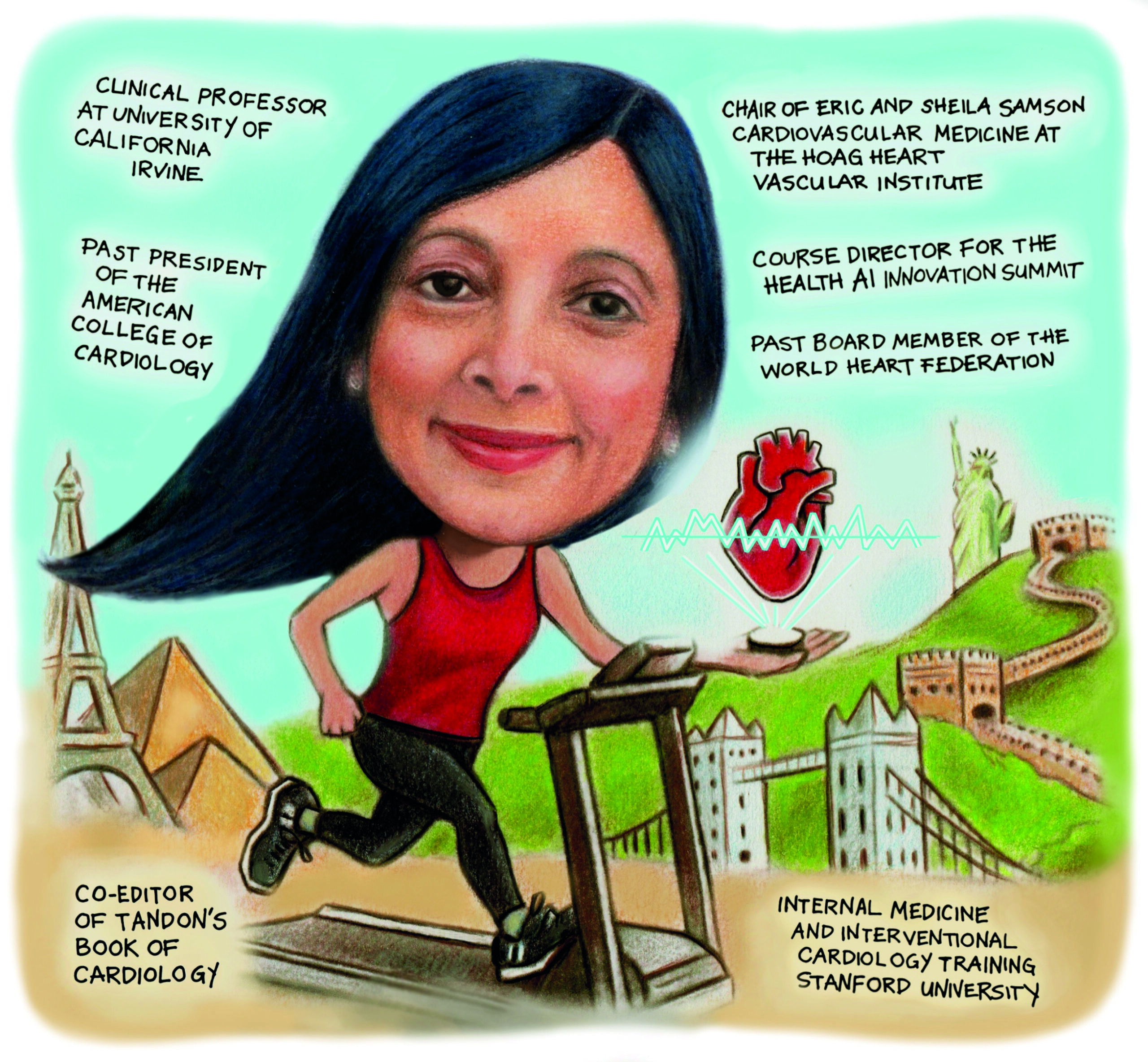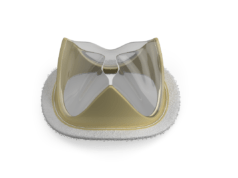 Serving as the president of the American College of Cardiology (ACC) during the height of the COVID-19 pandemic, Dipti Itchhaporia, an interventional cardiologist at the Hoag Heart and Vascular Institute (Newport, USA) who holds the Eric & Shelia Samson Endowed Chair in Cardiovascular Health, has seen first hand the importance of digital transformation in cardiovascular care. She talks to Cardiovascular News about her research and life in medicine.
Serving as the president of the American College of Cardiology (ACC) during the height of the COVID-19 pandemic, Dipti Itchhaporia, an interventional cardiologist at the Hoag Heart and Vascular Institute (Newport, USA) who holds the Eric & Shelia Samson Endowed Chair in Cardiovascular Health, has seen first hand the importance of digital transformation in cardiovascular care. She talks to Cardiovascular News about her research and life in medicine.
What drew you to medicine and to interventional cardiology in particular?
I have always had a strong interest in health and medicine, growing up in a family of physicians. As a child, I would often spend time at my grandmother’s house, where my uncle, a family practice doctor, ran his clinic. I would watch him work, fascinated by the interactions and the care he provided. Medicine seemed to offer the perfect blend of science, which I’ve always loved, and the ability to make tangible difference in people’s lives. That combination is what initially drew me to the field.
In high school and college, I was also heavily involved in journalism and served as the editor of the student newspaper. At one point, a friend encouraged me to pursue journalism, but the way I saw it, I could still write as a doctor, but I couldn’t practice medicine if I only wrote. Choosing medicine kept a world of options open.
Cardiology stood out for me because of its fast pace and the immediate impact you can make, particularly in interventional cardiology. I was especially drawn to treating patients with ST-elevation myocardial infarction (STEMI) where the improvement can be dramatic and immediate.
Beyond the urgency and intensity, what makes cardiology so meaningful is its broad impact—cardiovascular disease remains the leading cause of death globally. The field also offers deep intellectual and scientific challenges, and it is a privilege to earn the trust of patients during some of the most critical moments of their lives.
Who are the individuals that have helped to shape your career?
Many individuals have played a role in shaping my career and the way I practice medicine. From the beginning, my parents instilled in me the importance of hard work, compassion and dedication—values that continue to guide me every day. One of my earliest mentors outside of medicine was my high school journalism teacher. She helped me develop the communication and interpersonal skills that are so essential in healthcare.
During medical school, Michael McGuire, an orthopaedic surgeon who was a friend and mentor inspired me with his genuine love for medicine and for connecting with patients. I’ve been fortunate to train at institutions like Stanford and Georgetown, where I had the privilege of learning from many brilliant and dedicated clinicians. Each of them influenced me in different ways, making it difficult to single out just one person. Collectively, their mentorship, examples and support have shaped not only my clinical skills, but also the kind of physician I strive to be.
What has been the biggest change in the field over your career?
Transcatheter aortic valve implantation (TAVI) stands out as the most transformative advancement. The first TAVI was performed over 20 years ago by Alain Cribier—a good friend of mine. My only ACC presidential citation went to him for his profound impact on cardiovascular care. While we’ve seen remarkable progress in percutaneous therapies, increased adoption of minimally invasive procedures, and expanded use of imaging in interventional cardiology, no innovation has had a greater impact on patient outcomes across such a broad population as TAVI.
Have there been any disappointments?
My very first publication, over 20 years ago, focused on neural networks in cardiology. While we’re finally beginning to see innovations in artificial intelligence (AI) enter the field, the progress has been frustratingly slow. Even now, AI has yet to be integrated in a truly meaningful way. I hope that within my lifetime, we will move beyond simply discussing the potential of AI in cardiology and healthcare—and begin to speak confidently about its real-world applications.
What are your research priorities?
My primary focus is on digital health and innovation. During my presidential year, I spoke often about the promise of digital transformation in healthcare. While there’s growing interest in AI, data analytics, and home-based care, the true leap forward has yet to occur. Much is said about the digital divide, but I believe we need to rethink the entire model of healthcare delivery. I hope to see digital health become as seamlessly integrated into our lives as smartphones have.
Are there pitfalls to having more AI in healthcare?
Privacy is a major concern—especially when sensitive patient data is involved. Accountability is another complex issue: if an adverse event occurs following an AI-driven decision, who is ultimately responsible—the AI system, its developer, or the clinician who acted on the recommendation? We also need to be cautious about becoming over-reliant on AI; technology should augment, not replace, clinical judgment. Additionally, the risk of deepening the digital divide is real, potentially leaving certain populations behind. These challenges underscore the need for thoughtful regulation, equitable access, and robust data governance as we integrate AI into healthcare.
Which recent trials caught your eye?

In 2025, two areas of cardiology have stood out for their clinical and scientific impact: TAVI and lipoprotein(a)—Lp(a)—targeted therapies. NOTION-2 broke new ground by enrolling low-risk patients under 75 years old—many with bicuspid aortic valves—into a head-to-head comparison of TAVI versus surgical aortic valve replacement (SAVR). At one year, composite outcomes were comparable between TAVI and SAVR, but nuances emerged: TAVI patients experienced higher rates of non-disabling stroke and paravalvular regurgitation, yet benefited from quicker recovery and improved quality of life. A meta-analysis of over 7,700 patients with long-term follow-up further reinforced TAVI’s safety and durability across surgical risk groups, supporting broader application in younger, lower-risk populations.
Meanwhile, the field of Lp(a)-lowering therapies has rapidly advanced, with multiple phase 3 trials underway. Agents such as lepodisiran—an siRNA therapy shown to reduce Lp(a) levels by more than 90%—hold promise for addressing a major unmet need in cardiovascular prevention. As Lp(a) becomes recognised as an independent risk factor for atherosclerotic disease, these trials may mark a turning point in personalised lipid management and long-term vascular risk reduction.
What will be the next evolution for the field of interventional cardiology?
I believe we’ll continue to see significant advances in minimally invasive techniques, with percutaneous interventions expanding beyond percutaneous coronary intervention (PCI) and even beyond cardiology. Robotics and automation, will play a larger role, potentially leading to more precise procedures, faster recovery times, and improved outcomes, AI and data-driven analytics will help streamline care and enhance safety, while augmented reality will offer better visualisation during interventions.
Another exciting frontier is phenotype detection. We perform extensive imaging, yet we only analyse a fraction of the data available. There’s enormous untapped potential to uncover connections and insights we’ve previously overlooked.
What truly excites me is the vision of creating lifelong health profiles—starting at birth—so we can continuously learn from individual data. This would allow us to predict and catch health issues early, shifting care from reactive to proactive. It’s a big dream, but one that can fundamentally change how we approach healthcare—moving away from sick care to early, personalised prevention.
What are the biggest challenges to improving health equity?
One major challenge is acknowledging that the healthcare we deliver only determines 20% of a person’s health outcomes—the remaining 80% is influenced by social determinants like income, education, housing, and access to healthy food. For cardiologists and healthcare clinicians who are already working incredibly hard, it can feel overwhelming to take on that broader 80%. But if we truly want to improve outcomes, we can’t ignore it.
We need to be strong advocates for policies that address these root causes. We also need greater transparency in the healthcare system, especially around costs, so that patients facing hardship can still receive care that aligns with their best interests. Without systemic change, equity will remain out of reach.
What is needed for interventional cardiology to attract the best talent?
Work-life balance has always been a concern, and it’s becoming more critical as women enter medicine. I recently read that for the first time, women will outnumber men in the UK National Health Service (NHS). If this continues and we want top-tier talent to enter interventional cardiology, we have to address structural challenges that disproportionately affect women and young physicians.
We are making progress in areas like radiation safety, and with advances in automation, robotics, and AI-enhanced imaging we have the potential to further reduce exposure, particularly compared to traditional angiographic procedures.
Just as important, we need to show young physicians that this work has real impact. It’s essential to inspire them—not just with the promise of a career, but with a sense of purpose. Mentorship plays a crucial role here. We must be intentional about fostering a culture that values contribution, growth, and meaning—not just financial rewards.
What is your most memorable case?
It’s hard to single out just one case. What stays with me most are the patients that we saved, it reminds me why the work matters. In a field that can be physically and emotionally demanding, those moments provide a sense of purpose. At tough times, I try to remember that any one of us could be a patient someday, and that helps me stay grounded in compassion.
What is the legacy from your ACC presidency?
I served as president during the pandemic, which shaped my tenure in unique and unprecedented ways. One challenge was finding new ways to connect with members in the absence of traditional travel and in-person meetings. I launched the Coffee with the ACC President series—a virtual initiative that created a meaningful avenue for engagement during a difficult time that has endured as a lasting platform. Even now I hear from members who found it valuable and impactful.
Maintaining optimism within the cardiovascular community was another important focus. I emphasised continued education and championed digital transformation—recognising that as a technologically advanced specialty, cardiology must continue to evolve or risk falling behind.
The pandemic also brought the issue of health equity into sharper focus. The ACC Health Equity Taskforce, which I headed in my vice presidential year, was embedded into the culture of the college and has started the conversation in a meaningful way.
What occupies you outside of medicine?
Life beyond medicine is deeply fulfilling. I make time to reflect on what else life has to offer beyond a professional career. Relationships with family and friends are important to me, and I feel fortunate that both of my parents are still with us. Travel remains a passion of mine and I continue to explore new places whenever I can. I also enjoy watching movies, they have a unique ability to transport you to different worlds and moments in time. Gran Turismo is a particular favourite, I found it particularly inspirational.
FACT FILE
Appointments
Hoag Heart and Vascular Institute: Eric & Sheila Samson Endowed Chair in Cardiovascular Health
University of California, Irvine: Clinical Professor
American College of Cardiology: President (2021–2022)
HealthTech Horizons: AI & Digital Innovation Summit: Chair
Education & Training
Saint Louis University School of Medicine, MD
Santa Clara Valley Medical Center, Internship, Internal Medicine
Stanford University Medical Center, Residency, Internal Medicine
Georgetown University Medical Center, Cardiology Fellowship
Stanford University Medical Center, Interventional Cardiology Fellowship
Fellowships and Honours
American College of Cardiology, Fellow
European Society of Cardiology, Fellow
British Cardiovascular Society, Honorary Member










